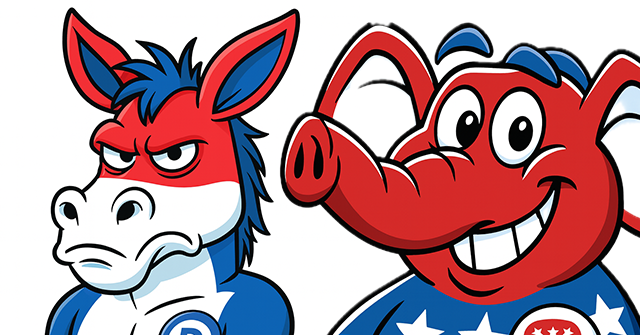The Bright Trump Economy vs. the Dismal Democrats
The Democrats are once again a party of Gloomdogglers.
The term gloomdoggler was first coined by Stephen Hess, a speech writer for President Dwight Eisenhower. The term was derived from the Great Depression era word boondoggler that Republicans had deployed against Democrats. A boondoggler was someone who created unnecessary work. A gloomdoggler was someone ginning up unnecessary gloom.
The depth of Democratic gloom about the economy is striking. Before getting into the details, however, let’s review the current state of the economy. Gross Domestic Product rose at a 3.8 percent pace in the second quarter and the Atlanta Fed’s GDPNow say it is on track to do so again. Thanks to the shutdown, we do not have September’s unemployment rate yet, but it was 4.3 percent in August, and most economists do not expect it changed much. Consumer spending is growing rapidly, supported by the still strong labor market.
Inflation remains elevated at 2.9 percent but is far below the highs hit under Biden, and there are no signs tariffs are creating inflationary pressures. Instead of retaliating against President Trump’s tariffs, our trading partners are cutting trade deals that are more favorable to the U.S. Wages are growing faster than inflation, meaning everyday goods and services households buy are becoming more affordable. The stock market is up 14.3 percent year-to-date, a spectacular rise, and the Federal Reserve is finally bringing down interest rates. Businesses are investing in plants and equipment, in part due to the tax breaks in the recent Republican tax cut bill.
This is a picture of a solid economy. This is not to say there are no spots of weakness or causes for concern. Interest rates are still too high to unlock the housing market. Construction employment is likely to fall as the inventory of newly built homes climbs and housing starts slump. That would put pressure on the labor market, which could also trigger a pullback in consumer spending, dampening growth. The Fed could slow-walk its rate cuts, putting further pressure on growth.
The End Is Nigh…for Liberals and Democrats
None of that, however, explains the dismal view of the economy among Democrats and especially self-described liberals. The latest survey by YouGov for the Economist shows that 36 percent of liberals say they expect to be worse off financially a year from now, compared to 25 percent of moderates and 11 percent of conservatives. By party affiliation, only 11 percent of Democrats say they expect to be better off, compared with 22 percent of independents and 42 percent of Republicans.
Eighty-one percent of liberals and 78 percent of Democrats say the economy is getting worse. That compares to 55 percent of moderates and 63 percent of independents. Just 24 percent of conservatives and 19 percent of Republicans say it is getting worse. And you’ll find almost no optimists on the American left: just four percent of liberals and Democrats say the economy is getting better, compared to 12 percent of moderates and 11 percent of independents. Conservatives and Republicans take a much sunnier view, with 44 percent of the former and 43 percent of the latter saying things are getting better economically.
The media consumed by liberals and Democrats reflects—and perhaps contributes—to this gloomdoggery. Seventy-three percent of liberals and 68 percent of Democrats say the news stories they are hearing about the economy are mostly negative. Among moderates and independents, the mostly negative news comes in at 48 percent and 52 percent. Among conservatives and Republicans, 29 percent and 24 percent.
The most dismal view held by Democrats and liberals, however, is not about the near-term economic prospects but the long-term. Seventy-one percent of liberals say that children today will be worse off financially than their parents. For Democrats, it is 60 percent. Moderates come in at 46 percent and independents at a still pessimistic 54 percent. Even among conservatives and Republicans, the numbers are not all that optimistic at 39 percent and 34 percent, respectively.
It’s hard to know how much of this is simply partisanship and how much of it is genuine gloominess. We’re inclined to take people at their word and assume that Democrats really do think the economic skies are falling and will keep falling for a generation.
Read the full article here


